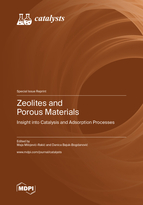Zeolites and Porous Materials: Insight into Catalysis and Adsorption Processes
A special issue of Catalysts (ISSN 2073-4344). This special issue belongs to the section "Catalytic Materials".
Deadline for manuscript submissions: closed (31 January 2023) | Viewed by 25847
Special Issue Editors
Interests: zeolites and zeolite-based composites; synthesis and characterization of materials for application in environmental studies; chemical kinetics and catalysis; adsorption of pollutants
Special Issue Information
Dear Colleagues,
Zeolites and porous materials, in general, are some of the most promising host materials for association with various active constituents. Zeolites represent a family of highly ordered systems with pores, which, along with high specific surface and negatively charged framework, enable the introduction of different functionalizing phases. Excellent adsorption and catalytic properties are often ascribed, and further research is increasingly being transferred to the domain of biological applications. Zeolites are currently regarded as dietary super-materials and this, sometimes, is an overstatement. Every drugstore is selling zeolite-based nutritional formulations enhanced with vitamins, enzymes, etc., often without any scientific basis to support the claims of high nutritional benefits. Antioxidant, antimicrobial, detoxifying, and anticancer activity is often attributed to both synthetic and natural zeolites. However, a strict survey of the available literature provides somewhat controversial findings—do zeolites represent the best choice, or do a series of improvements/added functionalities need to be incorporated to obtain efficient samples? This is a challenging question, and improvements in the area are quite versatile. This issue intends to highlight the true and essential applications of zeolites and porous materials primarily in adsorption and catalysis, but also in other areas of research.
Submissions to this Special Issue on “Zeolites and Porous Materials: Insight into Catalysis and Adsorption Processes” are welcome in the form of original research papers or short reviews that reflect the state of research in this field on the following topics: all studies related to the application of zeolites in industrial catalysis, separation technology, environmental protection, electrochemistry, membranes, sensors, optical devices, etc.; synthesis and physicochemical characterization of porous and zeolite-based materials; functionalization/modifications of zeolites, composites comprising natural and synthetic zeolites and porous matrices; adsorption (and other separation techniques) using porous adsorbents; Catalysis by zeolite-based materials and host/guest interactions; and theoretical modelling of catalysis/adsorption by porous materials.
Dr. Maja Milojević-Rakić
Dr. Danica Bajuk-Bogdanović
Guest Editors
Manuscript Submission Information
Manuscripts should be submitted online at www.mdpi.com by registering and logging in to this website. Once you are registered, click here to go to the submission form. Manuscripts can be submitted until the deadline. All submissions that pass pre-check are peer-reviewed. Accepted papers will be published continuously in the journal (as soon as accepted) and will be listed together on the special issue website. Research articles, review articles as well as short communications are invited. For planned papers, a title and short abstract (about 100 words) can be sent to the Editorial Office for announcement on this website.
Submitted manuscripts should not have been published previously, nor be under consideration for publication elsewhere (except conference proceedings papers). All manuscripts are thoroughly refereed through a single-blind peer-review process. A guide for authors and other relevant information for submission of manuscripts is available on the Instructions for Authors page. Catalysts is an international peer-reviewed open access monthly journal published by MDPI.
Please visit the Instructions for Authors page before submitting a manuscript. The Article Processing Charge (APC) for publication in this open access journal is 2700 CHF (Swiss Francs). Submitted papers should be well formatted and use good English. Authors may use MDPI's English editing service prior to publication or during author revisions.
Keywords
- all studies related to the application of porous materials in industrial catalysis, separation technology, environmental protection, electrochemistry, membranes, sensors, optical devices, etc.
- the synthesis and physico-chemical characterization of zeolite-based materials
- functionalization/modifications of zeolites, composites comprising natural and synthetic zeolites/porous matrices
- adsorption (and other separation techniques) using porous adsorbents
- catalysis by zeolite-based materials and host/guest interactions
- theoretical modeling of adsorption/catalysis comprising porous materials







